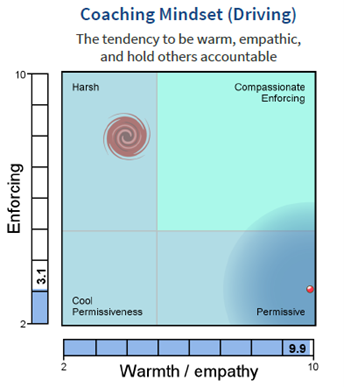The impact of preferences on behaviour
In my article entitled “Can you be too helpful for your own good” I began by outlining the effect behavioural preferences, whether strong or weak, can have on success. I further outlined the underpinning theories behind the Harrison Assessment resource that we at ACC have expertise with. We then explored the interplay of an “Assertive” trait and a “Helpful” trait and the impact they can have on the use of a leader’s power. You can click this link to see that article.
I’d now like to explore another pair of paradoxical trails and their potential impact on a leader’s/manager’s ability to ensure high standards are met and at the same time ensuring team members feel valued and cared for. It is a paradox known as “Coaching Mindset” or “Driving”. It considers an individual’s tendency to implement accountability to ensure high standards, and yet at the same time creating a warm and empathetic culture.
The two traits involved are:
- Enforcing (the tendency to insist upon necessary rules being followed)
- Warmth/Empathy (the tendency to express positive feelings and affinity towards others).
You can sense the tension or paradoxical nature of these traits. Enforcing is all about being able to ensure rules and standards are followed even when people don’t like it and may get defensive. Warmth/Empathy is all about having an open heart and recognising the feelings of others.
This is another paradox that many of my clients have out of balance. This graph shows an individual whose “Warmth/Empathy” trait is much higher than their “Enforcing” trait.

You will note in this diagram that the shaded circle (their normal range of behaviour) is predominately in the lower right quadrant, titled “Permissive”. This eventuates when a leader is far more concerned with being “liked” than with ensuring standards are met. But again, as with any imbalance, there are unintended consequences (UCs) as a result. These may include:
- Poor performance due to complacency
- Decreased accountability
- Unnecessary mistakes and losses
- Resentment and passive resistance (especially from those who are diligent)
- Poor teamwork due to bad behaviour
Conversely, an imbalance the other way would result in “Harsh” behaviour. UCs in this instance may include:
- Resentful compliance to rules
- No discretion for team members
- Demotivating others to perform
- Costly employee turnover
- Maintaining unbeneficial rules
- Mistrust and lack of teamwork
Do you recognise any of these from your own experience?
Of course, the ideal behaviour to ensure this paradox is of help, is found in the upper right quadrant of “Compassionate Enforcing”. The answer is not being less enforcing or less warm, but to work at developing the lower trait to ensure a more balanced range of behaviour is achieved. This may sound simple, but as traits are habitually learned preferences, they can prove difficult to shift. This is where the help of a coach can be beneficial.
So, can you keep the standards high and be nice? The answer is yes. However, if you can’t utilise a similarly substantial degree of enforcing and warmth, it creates the unintended consequences of being either permissive or harsh, both of which will have a hindering effect on success.
One more point. You will notice on the above graph a “cyclone” in the upper left quadrant. This is what we call “flip behaviour” and results from an imbalance in the traits and stress in an individual’s life. In this instance, under stress, this person is likely to experience an emotional flip to the opposite quadrant. For instance, after normal patterns of permissive behaviour resulting in standards declining, deadlines not being met, resentment building, and the leader is not managing stress well, emotions can drive an opposite reaction. The problem here is that behaviour is driven by emotion instead of reason, which is never helpful. Notice the reaction is harsh, not enforcing, so the behaviour is destructive rather than helpful. Warmth and empathy temporarily go out the window. The key is to actively develop the enforcing trait, to avoid the flip and move the normal range of behaviour into the compassionate enforcing quadrant.
I wonder if you can estimate the degree to which you have each of these traits, and how that has helped or hindered you in your leadership. It may well be worth considering completing a Harrison Assessment to determine this and many other helpful aspects of the assessments.
We will explore more of these paradoxes in future articles. In the meantime, if you would like more information on Harrison Assessments, feel free to contact us or you can contact me personally directly at [email protected]



